Five Unusual Fictional Murder Methods
By Maggie James
Warning - plot spoilers!
Warning - by its nature, this blog post contains plot spoilers! It's impossible for me to reveal how these five novelists created their fictional murders without giving away essential elements of the plot. If you're OK with that, then read on... An incredible (and edible!) murder weapon
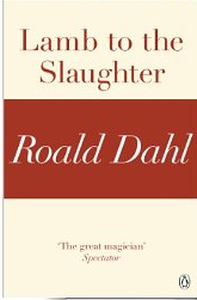 As part of my 'Five' series, in today's post I'll examine five unusual fictional murder methods. Crime writers often endeavour to come up with ever more creative ways to murder their characters, despite the fact that more orthodox methods such as guns and knives tend to be more convincing. Most people have heard of 'death by icicle' in both books and movies, and I'll share an example later.
As part of my 'Five' series, in today's post I'll examine five unusual fictional murder methods. Crime writers often endeavour to come up with ever more creative ways to murder their characters, despite the fact that more orthodox methods such as guns and knives tend to be more convincing. Most people have heard of 'death by icicle' in both books and movies, and I'll share an example later.
One of the most famous murder methods employed by fictional writers is the one used by Roald Dahl in his short story 'Lamb to the Slaughter'. The story tells of a wife who, after learning that her husband plans to leave her, decides to kill him. She bludgeons him with a frozen leg of lamb, then cooks the meat and serves it to the police officers who investigate her husband's death. Ingenious, huh? What a great way to dispose of a murder weapon! And yet another twist on the theme of death by ice.
'Lamb to the Slaughter' is a wonderful short story, but novels are more my thing. So let's examine five examples in which the authors have given their characters ingenious methods for carrying out their murderous intentions. We'll start with P.M. Carlson's 'Murder in the Dog Days'.
1 - 'Murder in the Dog Days' - P.M. Carlson
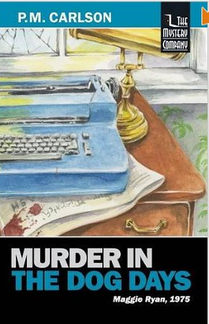 'Murder in the Dog Days' by P. M. Carlson (1990) is a great example of what's known as 'the locked room mystery'. In a story of this genre, a crime, usually murder, is committed in circumstances that appear inexplicable. As the name suggests, a locked room is involved, one in which the murderer apparently could neither have entered nor left.
'Murder in the Dog Days' by P. M. Carlson (1990) is a great example of what's known as 'the locked room mystery'. In a story of this genre, a crime, usually murder, is committed in circumstances that appear inexplicable. As the name suggests, a locked room is involved, one in which the murderer apparently could neither have entered nor left.
Here's a brief plot synopsis of Carlson's novel. On a sweltering summer day, (the temperature is highly significant) reporter Olivia Kerr and her husband Jerry invite Olivia's colleague Dale Colby to the beach. At the last minute, Dale decides to remain behind, and his dead body is discovered later on in his locked office.
Already an ill man, Dale dies as a result of heatstroke when the temperature of his study reaches an intolerable level. His killer contrives the murder by manipulating the heat in the office via a thermostat, raising it during the day and then readjusting it before the body is discovered. As the office door is bolted on the inside, the crime scene appears to be a perfect locked room murder.
2 - 'Busman's Honeymoon' - Dorothy Sayers
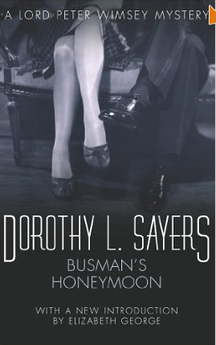 'Busman's Honeymoon' (1937) is one of Dorothy Sayers's novels involving Lord Peter Wimsey. Wimsey is on honeymoon with his new wife, Harriet, at Talboys, an old farmhouse that Wimsey has bought for her. On the morning after their arrival, they discover the former owner, Noakes, dead in the cellar with head injuries. The house was locked and bolted when the newly-weds arrived, and medical evidence seems to rule out an accident, so it appears he was attacked in the house and died later, having somehow locked up after his attacker. Another locked room - or, for the pedantic, locked house - murder!
'Busman's Honeymoon' (1937) is one of Dorothy Sayers's novels involving Lord Peter Wimsey. Wimsey is on honeymoon with his new wife, Harriet, at Talboys, an old farmhouse that Wimsey has bought for her. On the morning after their arrival, they discover the former owner, Noakes, dead in the cellar with head injuries. The house was locked and bolted when the newly-weds arrived, and medical evidence seems to rule out an accident, so it appears he was attacked in the house and died later, having somehow locked up after his attacker. Another locked room - or, for the pedantic, locked house - murder!
By all acounts, Noakes was a thoroughly dislikable man, and as the police investigation continues, a number of people emerge as suspects. The killer turns out to be Crutchley, a local garage mechanic who also worked as Noakes's gardener. He planned to marry Noakes's niece and get his hands on the money she would inherit in her uncle's will. The ingenious method Crutchley used involved setting a booby trap with a weighted plant pot on a chain, triggered by Noakes opening the radio cabinet after locking up for the night.
3 - 'The Religious Body' - Catherine Aird
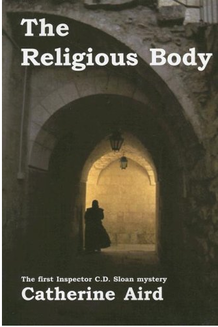 An interesting concept - convents aren't normally places one associates with violent murder. In 'The Religious Body', published in 1966, Inspector C.D Sloan has the task of solving the death of Sister Anne, who has been murdered, stashed in a broom closet, and then thrown down a flight of stairs into the cellar. A most unholy happening!
An interesting concept - convents aren't normally places one associates with violent murder. In 'The Religious Body', published in 1966, Inspector C.D Sloan has the task of solving the death of Sister Anne, who has been murdered, stashed in a broom closet, and then thrown down a flight of stairs into the cellar. A most unholy happening!
But how was Sister Anne killed? There is no apparent murder weapon to explain the blunt force trauma wounds inflicted before her tumble down the cellar steps. The answer is intriguing and, as the saying goes, hidden in plain sight. Catherine Aird's fictional murderer kills Sister Anne by delivering the fatal blows with one of the newel posts of a staircase. This unusual weapon is rendered more deadly by the heavy wooden ball atop its shaft. After the murder, the post is returned to its original position, to remain right under Inspector Sloan's nose as he investigates the death.
4 - 'A Big Boy Did It and Ran Away' - Christopher Brookmyre
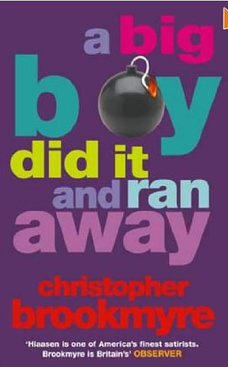 Christopher Brookmyre introduces not one but two ingenious murder methods in his novel 'A Big Boy Did It and Ran Away' (2001). As a student, the novel's character Simon Darcourt swaps dreams with his friend Ray Ash about the two of them becoming future rock stars. Fifteen years later, older and soured by life, they're struggling with the disappointments that have come their way. Whilst Ray seeks refuge from his parental responsibilities in online games, Simon chooses a much darker coping mechanism. For him, relief comes through serial killing, mass slaughter and professional assassination.
Christopher Brookmyre introduces not one but two ingenious murder methods in his novel 'A Big Boy Did It and Ran Away' (2001). As a student, the novel's character Simon Darcourt swaps dreams with his friend Ray Ash about the two of them becoming future rock stars. Fifteen years later, older and soured by life, they're struggling with the disappointments that have come their way. Whilst Ray seeks refuge from his parental responsibilities in online games, Simon chooses a much darker coping mechanism. For him, relief comes through serial killing, mass slaughter and professional assassination.
Simon's first murder in the novel is with a mercury-laden icicle, which melts away before the body is discovered. This fictional murder device, sometimes transmuted into an ice bullet, has been used many times, starting with Anna Katharine Green's novel 'Initials Only' (1911), in which a young woman is killed by an icicle shot from a pistol.
Simon's second murder is that of a drug dealer. Darcourt mixes a lethal amount of heroin into a takeaway curry and knocks on the man's door, claiming the food is a pre-paid order from that address. Too greedy to resist, the dealer dies, makes it appear as though his death was from the drugs he supplied. A great example of an unhealthy appetite!
5 - 'Matricide at St Martha's' - Ruth Dudley Edwards
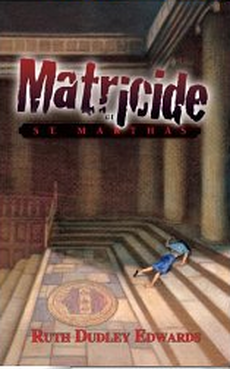 Perhaps the most contrived murder we'll examine today occurs in Ruth Dudley Edwards's 1995 novel 'Matricide at St Martha's'. St. Martha’s College, Cambridge, has been operating on a shoestring for decades, before being left a huge sum of money in a former student's will. The result? Large-scale infighting amongst the various college factions. Before long, one of these, the Virgins, led by Dame Maud Theodosia Buckbarrow, is taking the lead, its members believing the money should be spent on scholarships. Then Dame Maud is murdered...
Perhaps the most contrived murder we'll examine today occurs in Ruth Dudley Edwards's 1995 novel 'Matricide at St Martha's'. St. Martha’s College, Cambridge, has been operating on a shoestring for decades, before being left a huge sum of money in a former student's will. The result? Large-scale infighting amongst the various college factions. Before long, one of these, the Virgins, led by Dame Maud Theodosia Buckbarrow, is taking the lead, its members believing the money should be spent on scholarships. Then Dame Maud is murdered...
So how is this dastardly deed accomplished? Well, our victim climbs a ladder in the college library, the ladder being one of those that slide across the front of the bookcases via grooves in the wall. Normally, there are brakes at the end to stop the motion; however, in this case, the murderer has removed them. Following Dame Maud's own vigorous push to the ladder, she hurtles to her death as it gathers speed, eventually catapulting its hapless occupant from the library window. Give me some more examples!
I hope you have enjoyed this blog post! I'd be delighted to hear from you. Can you add any more examples to this catalogue of dastardly deaths? Have you read any novels where the murder method has struck you as unusually clever? Or maybe one that has made you throw the book aside and shout 'No way, Jose! That would never happen!' Leave a comment and let me know!
Subscribe to my newsletter and blog!
 I'd love to stay in contact with you! Why not sign up for my newsletter? It's an occasional communication to keep you informed about my new novel releases. I respect your privacy and will never sell your details to any third parties. To sign up, enter your details in the form at the top of the sidebar.
I'd love to stay in contact with you! Why not sign up for my newsletter? It's an occasional communication to keep you informed about my new novel releases. I respect your privacy and will never sell your details to any third parties. To sign up, enter your details in the form at the top of the sidebar.
And if you've enjoyed this blog post, how about subscribing via RSS feed or email? Either click the links in my blog sidebar or sign up via Networked Blogs, also in the sidebar. It'll be great to have you on board!
Warning - plot spoilers!
Warning - by its nature, this blog post contains plot spoilers! It's impossible for me to reveal how these five novelists created their fictional murders without giving away essential elements of the plot. If you're OK with that, then read on... An incredible (and edible!) murder weapon
 As part of my 'Five' series, in today's post I'll examine five unusual fictional murder methods. Crime writers often endeavour to come up with ever more creative ways to murder their characters, despite the fact that more orthodox methods such as guns and knives tend to be more convincing. Most people have heard of 'death by icicle' in both books and movies, and I'll share an example later.
As part of my 'Five' series, in today's post I'll examine five unusual fictional murder methods. Crime writers often endeavour to come up with ever more creative ways to murder their characters, despite the fact that more orthodox methods such as guns and knives tend to be more convincing. Most people have heard of 'death by icicle' in both books and movies, and I'll share an example later.One of the most famous murder methods employed by fictional writers is the one used by Roald Dahl in his short story 'Lamb to the Slaughter'. The story tells of a wife who, after learning that her husband plans to leave her, decides to kill him. She bludgeons him with a frozen leg of lamb, then cooks the meat and serves it to the police officers who investigate her husband's death. Ingenious, huh? What a great way to dispose of a murder weapon! And yet another twist on the theme of death by ice.
'Lamb to the Slaughter' is a wonderful short story, but novels are more my thing. So let's examine five examples in which the authors have given their characters ingenious methods for carrying out their murderous intentions. We'll start with P.M. Carlson's 'Murder in the Dog Days'.
1 - 'Murder in the Dog Days' - P.M. Carlson
 'Murder in the Dog Days' by P. M. Carlson (1990) is a great example of what's known as 'the locked room mystery'. In a story of this genre, a crime, usually murder, is committed in circumstances that appear inexplicable. As the name suggests, a locked room is involved, one in which the murderer apparently could neither have entered nor left.
'Murder in the Dog Days' by P. M. Carlson (1990) is a great example of what's known as 'the locked room mystery'. In a story of this genre, a crime, usually murder, is committed in circumstances that appear inexplicable. As the name suggests, a locked room is involved, one in which the murderer apparently could neither have entered nor left.Here's a brief plot synopsis of Carlson's novel. On a sweltering summer day, (the temperature is highly significant) reporter Olivia Kerr and her husband Jerry invite Olivia's colleague Dale Colby to the beach. At the last minute, Dale decides to remain behind, and his dead body is discovered later on in his locked office.
Already an ill man, Dale dies as a result of heatstroke when the temperature of his study reaches an intolerable level. His killer contrives the murder by manipulating the heat in the office via a thermostat, raising it during the day and then readjusting it before the body is discovered. As the office door is bolted on the inside, the crime scene appears to be a perfect locked room murder.
2 - 'Busman's Honeymoon' - Dorothy Sayers
 'Busman's Honeymoon' (1937) is one of Dorothy Sayers's novels involving Lord Peter Wimsey. Wimsey is on honeymoon with his new wife, Harriet, at Talboys, an old farmhouse that Wimsey has bought for her. On the morning after their arrival, they discover the former owner, Noakes, dead in the cellar with head injuries. The house was locked and bolted when the newly-weds arrived, and medical evidence seems to rule out an accident, so it appears he was attacked in the house and died later, having somehow locked up after his attacker. Another locked room - or, for the pedantic, locked house - murder!
'Busman's Honeymoon' (1937) is one of Dorothy Sayers's novels involving Lord Peter Wimsey. Wimsey is on honeymoon with his new wife, Harriet, at Talboys, an old farmhouse that Wimsey has bought for her. On the morning after their arrival, they discover the former owner, Noakes, dead in the cellar with head injuries. The house was locked and bolted when the newly-weds arrived, and medical evidence seems to rule out an accident, so it appears he was attacked in the house and died later, having somehow locked up after his attacker. Another locked room - or, for the pedantic, locked house - murder!By all acounts, Noakes was a thoroughly dislikable man, and as the police investigation continues, a number of people emerge as suspects. The killer turns out to be Crutchley, a local garage mechanic who also worked as Noakes's gardener. He planned to marry Noakes's niece and get his hands on the money she would inherit in her uncle's will. The ingenious method Crutchley used involved setting a booby trap with a weighted plant pot on a chain, triggered by Noakes opening the radio cabinet after locking up for the night.
3 - 'The Religious Body' - Catherine Aird
 An interesting concept - convents aren't normally places one associates with violent murder. In 'The Religious Body', published in 1966, Inspector C.D Sloan has the task of solving the death of Sister Anne, who has been murdered, stashed in a broom closet, and then thrown down a flight of stairs into the cellar. A most unholy happening!
An interesting concept - convents aren't normally places one associates with violent murder. In 'The Religious Body', published in 1966, Inspector C.D Sloan has the task of solving the death of Sister Anne, who has been murdered, stashed in a broom closet, and then thrown down a flight of stairs into the cellar. A most unholy happening!But how was Sister Anne killed? There is no apparent murder weapon to explain the blunt force trauma wounds inflicted before her tumble down the cellar steps. The answer is intriguing and, as the saying goes, hidden in plain sight. Catherine Aird's fictional murderer kills Sister Anne by delivering the fatal blows with one of the newel posts of a staircase. This unusual weapon is rendered more deadly by the heavy wooden ball atop its shaft. After the murder, the post is returned to its original position, to remain right under Inspector Sloan's nose as he investigates the death.
4 - 'A Big Boy Did It and Ran Away' - Christopher Brookmyre
 Christopher Brookmyre introduces not one but two ingenious murder methods in his novel 'A Big Boy Did It and Ran Away' (2001). As a student, the novel's character Simon Darcourt swaps dreams with his friend Ray Ash about the two of them becoming future rock stars. Fifteen years later, older and soured by life, they're struggling with the disappointments that have come their way. Whilst Ray seeks refuge from his parental responsibilities in online games, Simon chooses a much darker coping mechanism. For him, relief comes through serial killing, mass slaughter and professional assassination.
Christopher Brookmyre introduces not one but two ingenious murder methods in his novel 'A Big Boy Did It and Ran Away' (2001). As a student, the novel's character Simon Darcourt swaps dreams with his friend Ray Ash about the two of them becoming future rock stars. Fifteen years later, older and soured by life, they're struggling with the disappointments that have come their way. Whilst Ray seeks refuge from his parental responsibilities in online games, Simon chooses a much darker coping mechanism. For him, relief comes through serial killing, mass slaughter and professional assassination.Simon's first murder in the novel is with a mercury-laden icicle, which melts away before the body is discovered. This fictional murder device, sometimes transmuted into an ice bullet, has been used many times, starting with Anna Katharine Green's novel 'Initials Only' (1911), in which a young woman is killed by an icicle shot from a pistol.
Simon's second murder is that of a drug dealer. Darcourt mixes a lethal amount of heroin into a takeaway curry and knocks on the man's door, claiming the food is a pre-paid order from that address. Too greedy to resist, the dealer dies, makes it appear as though his death was from the drugs he supplied. A great example of an unhealthy appetite!
5 - 'Matricide at St Martha's' - Ruth Dudley Edwards
 Perhaps the most contrived murder we'll examine today occurs in Ruth Dudley Edwards's 1995 novel 'Matricide at St Martha's'. St. Martha’s College, Cambridge, has been operating on a shoestring for decades, before being left a huge sum of money in a former student's will. The result? Large-scale infighting amongst the various college factions. Before long, one of these, the Virgins, led by Dame Maud Theodosia Buckbarrow, is taking the lead, its members believing the money should be spent on scholarships. Then Dame Maud is murdered...
Perhaps the most contrived murder we'll examine today occurs in Ruth Dudley Edwards's 1995 novel 'Matricide at St Martha's'. St. Martha’s College, Cambridge, has been operating on a shoestring for decades, before being left a huge sum of money in a former student's will. The result? Large-scale infighting amongst the various college factions. Before long, one of these, the Virgins, led by Dame Maud Theodosia Buckbarrow, is taking the lead, its members believing the money should be spent on scholarships. Then Dame Maud is murdered...So how is this dastardly deed accomplished? Well, our victim climbs a ladder in the college library, the ladder being one of those that slide across the front of the bookcases via grooves in the wall. Normally, there are brakes at the end to stop the motion; however, in this case, the murderer has removed them. Following Dame Maud's own vigorous push to the ladder, she hurtles to her death as it gathers speed, eventually catapulting its hapless occupant from the library window. Give me some more examples!
I hope you have enjoyed this blog post! I'd be delighted to hear from you. Can you add any more examples to this catalogue of dastardly deaths? Have you read any novels where the murder method has struck you as unusually clever? Or maybe one that has made you throw the book aside and shout 'No way, Jose! That would never happen!' Leave a comment and let me know!
Subscribe to my newsletter and blog!
 I'd love to stay in contact with you! Why not sign up for my newsletter? It's an occasional communication to keep you informed about my new novel releases. I respect your privacy and will never sell your details to any third parties. To sign up, enter your details in the form at the top of the sidebar.
I'd love to stay in contact with you! Why not sign up for my newsletter? It's an occasional communication to keep you informed about my new novel releases. I respect your privacy and will never sell your details to any third parties. To sign up, enter your details in the form at the top of the sidebar.And if you've enjoyed this blog post, how about subscribing via RSS feed or email? Either click the links in my blog sidebar or sign up via Networked Blogs, also in the sidebar. It'll be great to have you on board!
Published on July 29, 2014 00:28
No comments have been added yet.



